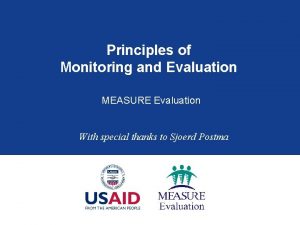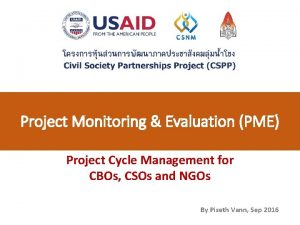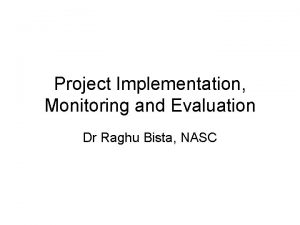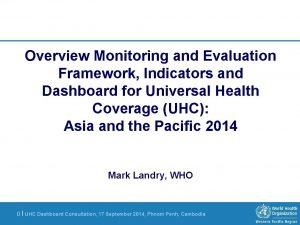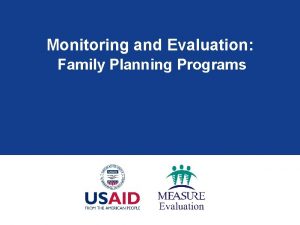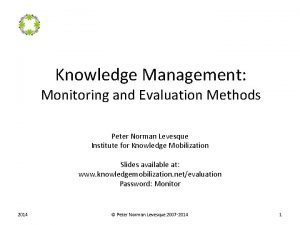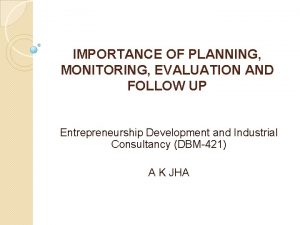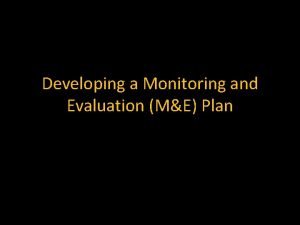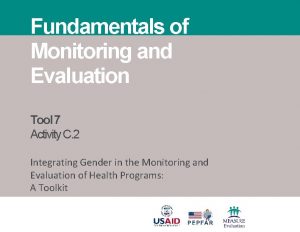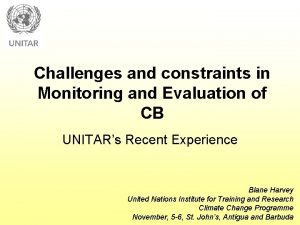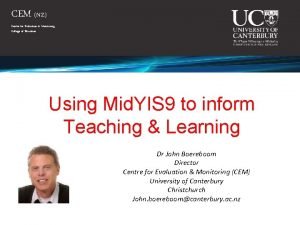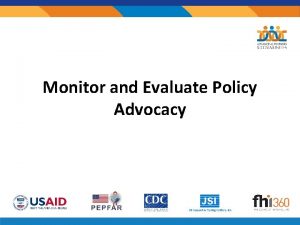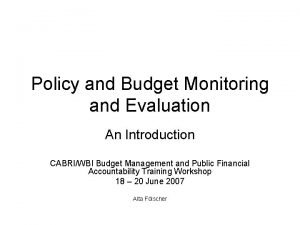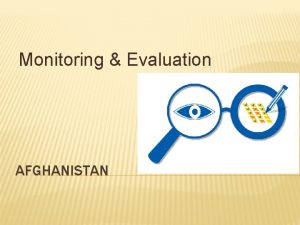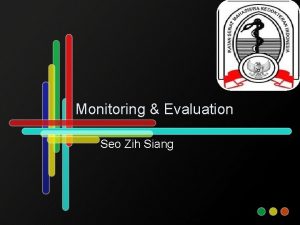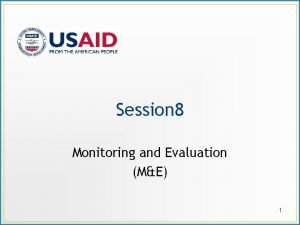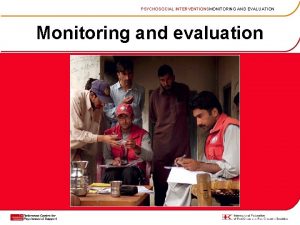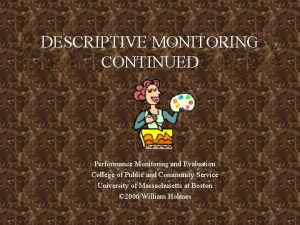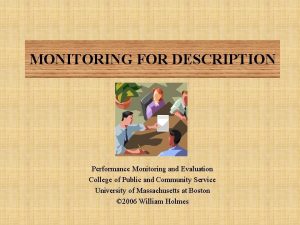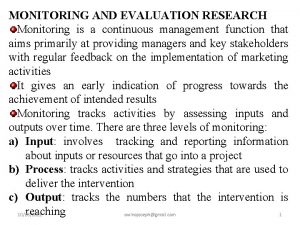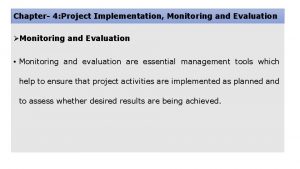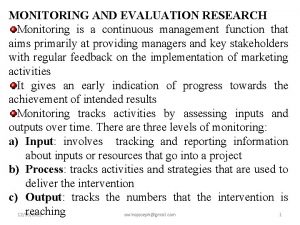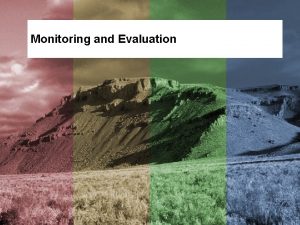Session 3 Principles of Monitoring and Evaluation Session















- Slides: 15

Session 3: Principles of Monitoring and Evaluation

Session Overview Purposes of M&E Definitions of monitoring and evaluation Definitions of program components Developing program frameworks

Session Learning Objectives By the end of the session, the participant will be able to: § explain the main purposes of M&E; § understand the difference between monitoring and evaluation; and § know the different program components and how to develop a framework with these components.

Purposes of M&E Improve programs by identifying the aspects that: § are working according to plan, and § those that need to be modified. Track changes in the interventions and in the desired outcomes. Reach informed decisions regarding the effective and efficient use of program resources.

Purposes of M&E Strengthen program design and improve program implementation. Generate knowledge, such as: § Identifying factors (individual, community, programmatic) that influence health outcomes. Justify the use of allocated resources. Meet an organizational requirement.

Key M&E Questions Did the program achieve its objectives? Did the target population benefit from the program? At what cost? Can improved health outcomes be attributed to program efforts? Which program activities were more (or less) important/effective?

What is Monitoring? Monitoring involves: § routine tracking of information about a program and its intended outputs, outcomes, and impacts; § measurement of progress toward achieving program objectives; § tracking costs and program/project functioning; § providing a basis for program evaluation when linked to a specific program.

What is Evaluation? Evaluation may involve: § activities designed to determine the value or worth of a specific program; § the use of special study designs or special studies to examine program effectiveness; § the examination of performance against defined standards, an assessment of actual and expected results, or the identification of relevant lessons.

Comparing M&E Monitoring: What are we doing? Tracking inputs and outputs to assess whether programs are performing according to plans (e. g. people trained, outbreaks investigated) Evaluation: What have we achieved? Assessment of impact of the program on behavior or health outcome (e. g. reporting sick poultry, AI case fatality ratio)

Logical Framework Definition: § Diagrams that identify and illustrate the linear relationships flowing from program inputs, processes, outputs, outcomes and impacts. § Inputs or resources affecting processes or activities that produce immediate results or outputs, ultimately leading to longer term or broader results, or outcomes. Purpose: § Provides a streamlined interpretation of planned use of resources and desired ends. § Clarifies project/program assumptions about linear relationships between key factors relevant to desired ends. Other terms used include M&E frameworks, indicator matrixes.

Key Terms Inputs: These may include human, financial, social, political, or other resources needed to begin and complete the program. Processes: Activities that produce immediate results – What will you be doing? Outputs: Involve immediate results from your processes – What are the results of your activities? Outcomes: Longer term or intermediate results – The progress towards achieving your objectives. Impact: Long-term changes necessary to sustain your goal.

Components of an Avian Influenza Program Population level Program level Inputs Processes Outputs Resources Functions, Activities Services Staff Drugs Supplies Equipment Training Logistics IEC Outcomes Intermediate % facilities providing quality Increased knowledge, Infection control behavior of ways to protect % backyard farmers poultry from AI receiving AI awareness materials # trained staff Utilization % commercial farmers vaccinating flocks Long-term Infection rate Mortality

Logical Framework: Training Activity INPUT Time and skills to develop new biosecurity training curriculum for market owners 13 PROCESS Conduct training events OUTPUT Market owners trained in biosecurity methods OUTCOME Improvement in market conditions IMPACT Reduction in HPAI/H 5 N 1 virus circulation

Small Group Activity Return to small groups Return to the program you described to: § develop a logical framework for at least three activities/processes of your program; and § work through inputs, processes (activities), outputs, outcomes, and impact. After about 30 minutes, we will reassemble and a member of each small group will share one logical framework.

Small Group Projects Present your findings to the group.
 7 principles of monitoring and evaluation
7 principles of monitoring and evaluation Principles of monitoring and evaluation
Principles of monitoring and evaluation What is visitor pre registration in picme
What is visitor pre registration in picme M&e cycle
M&e cycle Comparison between monitoring and evaluation
Comparison between monitoring and evaluation M&e dashboard
M&e dashboard Monitoring and evaluation of family planning programs
Monitoring and evaluation of family planning programs Knowledge management monitoring and evaluation
Knowledge management monitoring and evaluation Importance of planning, monitoring and evaluation
Importance of planning, monitoring and evaluation Monitoring plan sample
Monitoring plan sample Basics of monitoring and evaluation
Basics of monitoring and evaluation Monitoring and evaluation challenges
Monitoring and evaluation challenges Centre for evaluation and monitoring
Centre for evaluation and monitoring Differentiate monitoring and evaluation
Differentiate monitoring and evaluation Advocacy process 8 steps
Advocacy process 8 steps Budget monitoring and evaluation
Budget monitoring and evaluation
